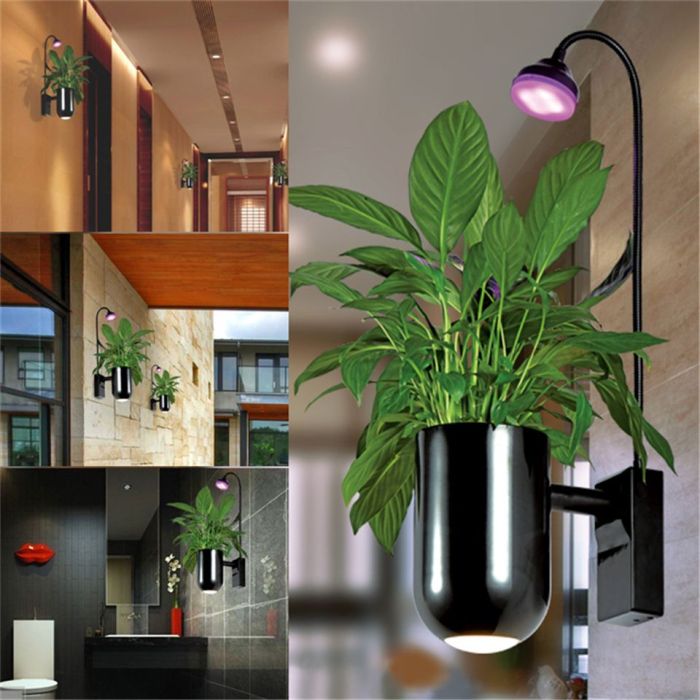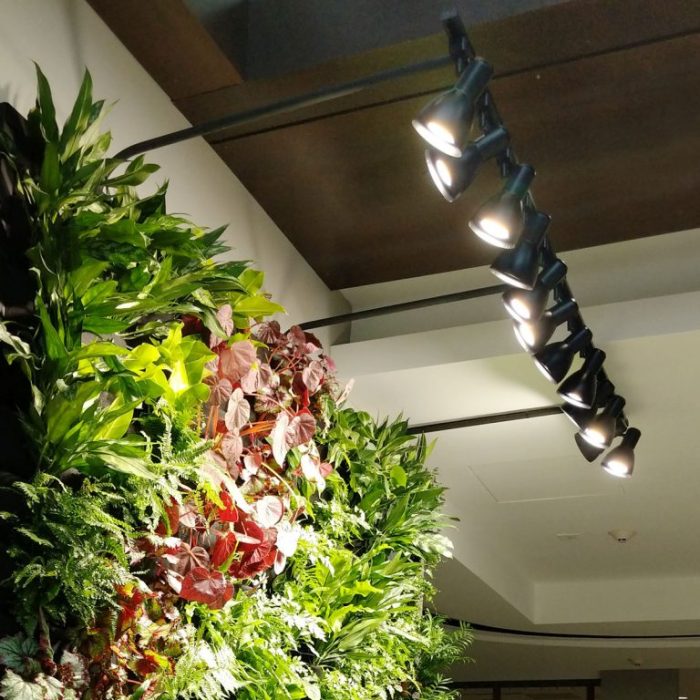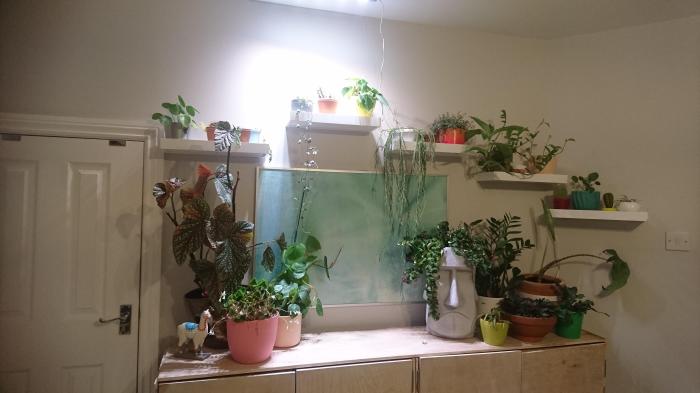Introducing wall mounted plant grow lights, an innovative solution for nurturing indoor plants with optimal growth and vitality. These specialized lighting systems provide targeted illumination, fostering healthy plant development and vibrant foliage in any indoor setting.
Wall mounted plant grow lights offer a myriad of benefits, including promoting photosynthesis, stimulating plant growth, and extending the growing season. They are particularly effective for plants that require high light levels, such as succulents, tropical plants, and seedlings.
Wall Mounted Plant Grow Light Overview
Wall-mounted plant grow lights are a type of indoor lighting designed to provide optimal light conditions for plant growth. They are typically mounted on a wall or ceiling, and emit a specific spectrum of light that is beneficial for photosynthesis and plant development.
With the increasing popularity of indoor gardening, wall mounted plant grow lights have become an essential tool for plant enthusiasts. These lights provide supplemental lighting to plants, allowing them to thrive in low-light conditions. For those looking to add a touch of greenery to their homes, Indoor Hanging Plants for Sale: Enhance Your Home with Greenery offers a wide selection of hanging plants that can complement any wall mounted plant grow light setup, creating a lush and inviting indoor oasis.
Using wall-mounted plant grow lights offers several advantages for indoor plant growth. These lights provide a consistent and controlled light source, which can be particularly beneficial in areas with limited natural light. They also allow for precise positioning of the light source, ensuring that plants receive the optimal amount of light they need to thrive.
Types of Wall-Mounted Plant Grow Lights
There are various types of wall-mounted plant grow lights available in the market, each with its own unique features and benefits. Some of the most common types include:
- Fluorescent grow lights:These lights are a cost-effective option and provide a good balance of light intensity and coverage. They are available in various sizes and shapes, making them suitable for a wide range of indoor growing spaces.
- LED grow lights:LED grow lights are highly efficient and offer a targeted light spectrum that is specifically tailored for plant growth. They are more expensive than fluorescent lights, but they have a longer lifespan and consume less energy.
- High-intensity discharge (HID) grow lights:HID grow lights emit a powerful light output and are suitable for larger indoor growing spaces. They are available in various types, including metal halide (MH) and high-pressure sodium (HPS) lights.
Features and Specifications
When selecting a wall-mounted plant grow light, several key features should be considered to ensure optimal plant growth and energy efficiency.
The light intensity, spectrum, coverage area, and energy efficiency are crucial factors to consider. These specifications vary depending on the type of plants being grown and the size of the growing space.
Light Intensity
Light intensity is measured in lumens or foot-candles and determines the amount of light the grow light provides. Higher light intensity is generally required for plants that require more sunlight, such as vegetables and flowering plants. Lower light intensity may be suitable for plants that prefer shade or indirect sunlight.
As a stylish and practical solution for illuminating indoor plants, wall mounted plant grow lights offer optimal lighting conditions while enhancing the aesthetic appeal of your home. To complement these lights, consider IKEA Indoor Plant Hangers , which provide a versatile way to display your plants at varying heights.
With their sleek designs and durable construction, these hangers allow you to create a lush indoor garden while adding a touch of elegance to your living space. The combination of wall mounted plant grow lights and IKEA Indoor Plant Hangers empowers you to nurture your plants and elevate your home decor simultaneously.
Spectrum
The spectrum of a grow light refers to the range of wavelengths of light it emits. Different wavelengths of light have different effects on plant growth. Blue light promotes vegetative growth, while red light encourages flowering and fruiting. Full-spectrum grow lights provide a combination of wavelengths to support all stages of plant development.
Coverage Area, Wall mounted plant grow light
The coverage area of a grow light determines the size of the growing space it can effectively illuminate. It is important to select a grow light that provides sufficient coverage for the plants being grown. Overlapping coverage areas can help ensure even light distribution.
Energy Efficiency
Energy efficiency is an important consideration, especially for long-term use. LED grow lights are typically more energy-efficient than traditional grow lights, consuming less power while providing comparable or even better light output.
The following table compares the specifications of different models of wall-mounted plant grow lights:
| Model | Light Intensity (lumens) | Spectrum | Coverage Area (sq. ft.) | Energy Efficiency (watts) |
|---|---|---|---|---|
| Model A | 10,000 | Full-spectrum | 4×4 | 100 |
| Model B | 15,000 | Blue and red spectrum | 3×3 | 120 |
| Model C | 20,000 | Adjustable spectrum | 5×5 | 150 |
Installation and Setup
Installing and setting up a wall-mounted plant grow light is a simple process that can be completed in a few easy steps.
While wall mounted plant grow lights provide ample illumination for indoor plants, consider complementing them with hanging glass planters. These stylish and functional containers elevate your decor, offering a touch of elegance and practicality. Hanging Glass Planters: Elevate Your Indoor Decor with Style and Functionality showcase a variety of designs and sizes, allowing you to create a stunning display that enhances the ambiance of any room.
Moreover, wall mounted plant grow lights ensure optimal growth conditions for your indoor plants, making them thrive in your home.
To begin, determine the optimal placement of the light for maximum plant growth. The light should be positioned directly above the plants, approximately 12-18 inches away. If the light is placed too close, it can burn the plants; if it is placed too far away, it will not provide enough light for growth.
Wall mounted plant grow lights provide a convenient and effective way to nurture indoor plants. They emit targeted light to promote growth, particularly for hanging plants like ferns, trailing ivy, and succulents. Hanging Plants require ample light, and wall mounted grow lights can supplement natural light, especially in rooms with limited windows or indirect sunlight.
The adjustable arms of these lights allow for precise positioning, ensuring optimal coverage and light intensity for healthy plant growth.
Materials Required
- Wall-mounted plant grow light
- Screws
- Drill
- Measuring tape
- Pencil
Step-by-Step Instructions
- Mark the location of the light on the wall using a pencil and measuring tape.
- Drill pilot holes into the wall at the marked locations.
- Screw the mounting bracket into the pilot holes.
- Attach the grow light to the mounting bracket.
- Plug the grow light into an electrical outlet.
Once the grow light is installed, it is important to adjust the light intensity and duration to meet the specific needs of the plants. Most grow lights come with adjustable settings that allow you to customize the light output.
Plant Care and Maintenance

Wall-mounted plant grow lights provide a controlled and efficient way to nurture indoor plants. By understanding the specific needs of different plant species, you can adjust the light intensity and duration to optimize their growth and well-being.
Light Intensity and Duration
Different plant types require varying levels of light intensity and duration. For instance, succulents and cacti thrive in high-intensity light for extended periods, while leafy greens prefer moderate light levels with shorter durations.
To determine the ideal light intensity for your plants, observe their natural habitats and consult plant care guides. Adjust the light intensity accordingly, using a dimmer or by adjusting the distance between the light and the plants.
Similarly, the duration of light exposure should be tailored to the plant’s needs. Most plants require 12-16 hours of light per day, but some species may benefit from longer or shorter durations.
Regular Maintenance and Cleaning
To ensure optimal performance, regular maintenance and cleaning of wall-mounted plant grow lights are essential. Dust and debris accumulation can reduce light output and affect plant growth. Clean the lights regularly with a soft cloth or brush to remove any build-up.
Additionally, check the bulbs or LEDs periodically and replace them when necessary. Burnt-out bulbs or dim LEDs can significantly reduce light intensity, compromising plant growth.
Advanced Techniques: Wall Mounted Plant Grow Light

For experienced growers seeking to optimize plant growth, advanced techniques using wall-mounted plant grow lights can yield exceptional results. These techniques involve harnessing technology to fine-tune light cycles, customize light spectra, and automate processes.
One advanced technique is utilizing timers and controllers to automate light cycles. This ensures consistent and precise light exposure, mimicking natural daylight patterns or creating customized schedules for different plant species. By programming specific on and off times, growers can optimize photosynthesis and plant development without manual intervention.
Custom Light Spectra
Another advanced technique is creating custom light spectra to tailor the light output to the specific needs of different plants. By adjusting the ratio of red, blue, and other wavelengths, growers can influence plant growth, flowering, and overall health. Specialized grow lights offer adjustable spectrums, allowing growers to experiment and optimize the light environment for maximum plant performance.
Closure

In conclusion, wall mounted plant grow lights are an essential tool for indoor plant enthusiasts seeking to cultivate thriving greenery. By providing precise and controlled illumination, these lights empower plants to reach their full potential, resulting in a flourishing indoor oasis.
Essential Questionnaire
What are the key features to consider when selecting a wall mounted plant grow light?
Key features include light intensity, spectrum, coverage area, energy efficiency, and ease of installation.
How do I install and set up a wall mounted plant grow light?
Follow the manufacturer’s instructions for proper installation and setup. Ensure the light is securely mounted and positioned for optimal plant growth.
Can I use wall mounted plant grow lights for all types of plants?
While suitable for most plants, it’s important to research specific plant needs and adjust light intensity and duration accordingly.